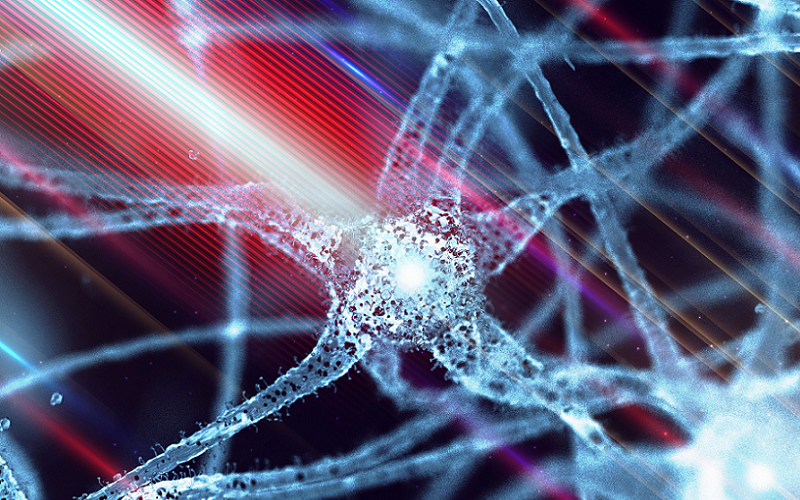
Light, an essential element of our daily lives, is not just a tool for vision but a significant influencer of our cognitive functions and mental health. Here we explore the fascinating ways in which different light spectrums interact with our brains, affecting everything from our sleep patterns to our cognitive abilities. From the energizing rays of blue light to the therapeutic potential of red and infrared light, each spectrum holds unique implications for brain health and functioning.
Contents
The Science Behind Light and the Brain
The relationship between light and the brain is a complex yet fascinating one. To fully appreciate how different light spectrums influence brain activity, we must first delve into the fundamental science governing this interaction.
Basic Principles of Light and Vision
At its core, light is a form of electromagnetic radiation that is visible to the human eye. The spectrum of light encompasses various wavelengths, each corresponding to different colors. These wavelengths are perceived by the retina in our eyes and converted into electrical signals. These signals are then transmitted to the brain, where they are interpreted as visual images. However, the impact of light goes beyond mere vision; it plays a pivotal role in various physiological and psychological processes.
How Light Interacts with the Brain
The human brain is intricately linked to light. One of the key pathways of interaction is through a small region in the hypothalamus known as the suprachiasmatic nucleus (SCN). This area acts as the body’s master clock, regulating circadian rhythms – our internal 24-hour cycle that governs sleep-wake patterns and other bodily functions.
When light enters the eyes, it not only provides us with vision but also influences the SCN, thereby impacting our circadian rhythms. This is primarily achieved through the absorption of light by a special type of cell in the retina called intrinsically photosensitive retinal ganglion cells (ipRGCs). These cells are particularly sensitive to blue light and play a crucial role in synchronizing our biological clock with the external light-dark cycle.
Different Types of Light Spectrums
Understanding the distinct types of light spectrums is crucial in comprehending their diverse effects on brain activity:
- Visible Light Spectrum: This includes all the colors we can see – from violet to red. Each color has a different wavelength and energy level, influencing our brain in various ways.
- Blue Light: Found at the shorter wavelength end of the visible spectrum, blue light is known for its high energy and is abundant in daylight. It’s especially influential in regulating our circadian rhythms and alertness levels.
- Red and Infrared Light: Positioned at the opposite end of the spectrum, these wavelengths are longer and have less energy. They are often associated with therapeutic effects, such as improving mood and cognitive function.
- Ultraviolet (UV) Light: While not visible to the human eye, UV light can have indirect effects on the brain, primarily through its impact on skin and hormonal balance.

Impact of Blue Light on Brain Activity
In our exploration of how different light spectrums affect the brain, blue light stands out due to its profound impact on various aspects of cognitive and physiological functions. Commonly associated with electronic screens and LED lighting, blue light has become an integral part of our daily lives, influencing our sleep, mood, and cognitive abilities.
Sources of Blue Light
Blue light is everywhere. It’s naturally emitted by the sun, which is why we associate a blue sky with daytime. However, in our modern world, we are also exposed to artificial sources of blue light through technology. Devices like smartphones, tablets, computer screens, and LED lighting are significant sources of blue light. This increased exposure, especially during evening hours, has raised concerns about its potential impact on our health [1].
Effects of Blue Light on Sleep and Circadian Rhythms
One of the most significant impacts of blue light is on our circadian rhythms, the internal biological clock that regulates our sleep-wake cycle. Exposure to blue light, particularly during evening hours, can suppress the production of melatonin, the hormone responsible for inducing sleep. This disruption can lead to difficulties in falling asleep, poor sleep quality, and overall disruption of our natural sleep patterns.
Research has shown that prolonged exposure to blue light at night can lead to a shift in circadian rhythms, making it harder for individuals to wake up early and stay alert during the day. This shift can have a cascading effect on various aspects of health, including metabolism, mood regulation, and cognitive function.
Cognitive Functions Influenced by Blue Light
The influence of blue light extends beyond sleep. Studies have indicated that exposure to blue light, especially during the daytime, can have positive effects on alertness, reaction times, and mood. The stimulating effect of blue light is thought to enhance cognitive performance and is being explored as a tool to improve concentration and productivity.
However, the timing of exposure is crucial. While daytime exposure to blue light can be beneficial, nighttime exposure can have the opposite effect, leading to decreased cognitive performance due to disrupted sleep patterns and potential eye strain [2].
Effects of Red and Infrared Light on Brain Activity
Moving from the stimulating effects of blue light, we turn our attention to the red and infrared spectrums of light. These wavelengths, often overlooked in daily life, possess unique characteristics that can have therapeutic effects on the brain and overall cognitive health.
Therapeutic Uses of Red and Infrared Light
Red and infrared light, known for their longer wavelengths, have been the focus of numerous therapeutic studies. These wavelengths are capable of penetrating deeper into the skin and tissue, which can stimulate cellular repair and regeneration. This property has made red and infrared light a popular choice in phototherapy treatments for various conditions, including skin issues, muscle repair, and even hair growth.
In terms of brain health, red and infrared light therapy has shown promise in improving blood flow to the brain. This increased circulation can enhance oxygen and nutrient delivery, which is essential for healthy brain function. There’s growing interest in the potential of these light spectrums in neurotherapy, particularly for conditions like traumatic brain injury, stroke recovery, and even in slowing the progression of neurodegenerative diseases.
Impact of Red and Infrared Light on Memory and Learning
Recent research has begun to explore the effects of red and infrared light on cognitive functions such as memory and learning. Preliminary studies have indicated that exposure to these light spectrums can stimulate mitochondrial function in neurons, which is crucial for energy production and cell health. This stimulation could potentially enhance cognitive functions, including memory recall and learning capacity [3].
The potential of red and infrared light in improving cognitive functions opens up exciting possibilities in the field of cognitive health, especially as a non-invasive treatment option for enhancing brain function and treating cognitive impairments.
Potential of Red and Infrared Light in Treating Brain Disorders
The therapeutic potential of red and infrared light extends to the treatment of various brain disorders. Clinical trials have begun investigating the effectiveness of these light spectrums in treating conditions like Alzheimer’s disease, Parkinson’s disease, and depression. The theory is that by enhancing mitochondrial function and promoting cell health, red and infrared light could help in managing or even reversing some symptoms associated with these disorders.
While the research in this area is still in its early stages, the initial findings are promising. The use of red and infrared light as a therapeutic tool offers a non-pharmacological approach to brain health, which could be particularly beneficial for individuals who are sensitive to medication or seeking alternative treatments.

Green Light and Its Effects on the Brain
As we continue to explore the spectrum of light and its influence on the brain, we arrive at the soothing realm of green light. This part of the spectrum, often associated with nature and tranquility, holds unique properties that can have surprising effects on brain activity and overall well-being.
The Calming Influence of Green Light
Green light, positioned in the middle of the visible spectrum, is known for its calming effects. Unlike the stimulating nature of blue light or the deep therapeutic properties of red and infrared light, green light is often perceived as gentle and soothing to the eyes and mind. This characteristic of green light has been leveraged in various settings, from creating relaxing environments in therapy spaces to being used in meditation practices.
Studies have shown that exposure to green light can result in lower stress levels, reduced anxiety, and an overall sense of calm. This effect is believed to be due to green light’s ability to reduce the strain on the eye, which in turn can help lower cortisol levels, the body’s primary stress hormone [4].
Green Light in Treating Migraines
An intriguing area of research in the use of green light is its potential in treating migraines. Migraine sufferers often find relief in darker, quieter environments, as bright or flickering lights can exacerbate their symptoms. Interestingly, some studies have indicated that exposure to a specific wavelength of green light can reduce the severity of migraine headaches. This is thought to be because this particular wavelength of green light produces less electrical activity in the brain, leading to reduced migraine pain.
This discovery has led to the development of green light therapy as a possible non-pharmacological treatment for migraines, offering hope to those who suffer from this debilitating condition.
Other Cognitive Benefits of Green Light
Apart from its calming effects and potential in migraine therapy, green light may also have other cognitive benefits. Preliminary research suggests that exposure to green light can enhance reading speed and comprehension, possibly due to its soothing effect on the visual system.
Furthermore, green light’s ability to create a serene environment may aid in concentration and focus, making it a potentially beneficial light spectrum in educational and work settings. These findings, while still in the early stages, point to the diverse ways in which green light can positively impact cognitive functions and mental well-being.
Ultraviolet Light and the Brain
Venturing beyond the visible light spectrum, we encounter ultraviolet (UV) light. While not directly perceivable by our eyes, UV light can have significant indirect effects on our brain and overall health. Understanding the role of UV light, often associated with sunlight, requires a careful consideration of its benefits and potential risks.
Risks of Ultraviolet Light Exposure
UV light, particularly UVB radiation, is well-known for its role in vitamin D synthesis in the skin. Vitamin D is essential for overall health, including brain health. It plays a role in neurodevelopment, brain function, and the prevention of cognitive decline. However, exposure to UV light also carries risks. Prolonged exposure to UV radiation can lead to skin damage, eye problems, and an increased risk of skin cancer [5].
The brain is protected from direct UV radiation by the skull and skin, but the indirect effects of UV exposure, such as the impact on circadian rhythms and vitamin D synthesis, can influence brain health. It’s crucial to find a balance between gaining the benefits of UV light and avoiding its harmful effects.
Ultraviolet Light in Medical Therapies
Despite its risks, UV light has therapeutic applications, particularly in treating certain skin conditions and mood disorders. For instance, UV light is used in the treatment of psoriasis and vitiligo. In terms of brain health, light therapy that mimics natural sunlight, which includes a component of UV light, has been effective in treating Seasonal Affective Disorder (SAD), a type of depression related to changes in seasons.
These therapeutic uses of UV light highlight its potential benefits, albeit in controlled environments to mitigate the associated risks. The influence of UV light on mood and circadian rhythms underscores the interconnectedness of our environment and brain health.
Precautions and Recommendations Regarding Ultraviolet Light
Given the mixed effects of UV light, precautions are necessary. When it comes to natural sunlight, moderation is key. It’s essential to balance sun exposure to benefit from vitamin D synthesis while avoiding the harmful effects of too much UV radiation. Using sun protection, such as sunscreen and protective clothing, and limiting direct sun exposure during peak UV radiation times are practical measures.
For therapeutic uses, it’s important to follow medical guidance to ensure that the benefits of UV light treatments outweigh the risks. Understanding these nuances allows us to appreciate the complex role of UV light in our health and well-being.
Ambient Light and Its Influence on Brain Activity
Beyond the specific effects of different light spectrums, the role of ambient light in our environment is a crucial aspect of how light influences brain activity. Ambient light encompasses the general lighting in our surroundings, whether natural or artificial, and its quality, intensity, and color can have significant impacts on our cognitive functions and mood.
Importance of Natural Light
Natural light, particularly sunlight, is essential for maintaining a healthy circadian rhythm and overall well-being. Exposure to natural light during the day helps regulate our sleep-wake cycle, improving sleep quality and mood. Sunlight also provides a balanced spectrum of light, which includes the beneficial blue light necessary for alertness and cognitive functioning.
The design of living and working spaces often emphasizes the importance of natural light. Studies have shown that workplaces and schools with ample natural light can enhance productivity, learning capabilities, and general mental health. This reinforces the idea that our environment plays a critical role in our cognitive health.
Effects of Artificial Ambient Light
In contrast to natural light, artificial ambient light, such as that from LED bulbs and fluorescent lights, can have different effects. The quality and type of artificial light can greatly influence our circadian rhythms, mood, and productivity. For instance, harsh, bright lighting can cause eye strain and headaches, while dim lighting can lead to drowsiness and lack of focus.
The color temperature of artificial light is also important. Warmer lights tend to be more calming and are better suited for evenings to promote relaxation and readiness for sleep. Cooler, bluish lights are more stimulating and are better used during the day to enhance alertness and concentration.
Best Ambient Light Practices for Healthy Brain Function
To optimize the influence of ambient light on brain activity, several best practices can be followed:
- Maximize Natural Light: Utilize windows and skylights to increase exposure to natural light during the day.
- Mindful Use of Artificial Light: Choose lighting options that mimic natural light as closely as possible. Pay attention to color temperatures and opt for warmer lights in the evening.
- Reduce Screen Time Before Bed: To minimize the impact of blue light from screens on sleep, reduce exposure to phones, tablets, and computers before bedtime.
- Use Light Therapy: For individuals living in areas with limited natural light or experiencing Seasonal Affective Disorder (SAD), light therapy using light boxes can be beneficial.
References
[1] Effects of Different Light Sources on Neural Activity of the Paraventricular Nucleus in the Hypothalamus
[2] How light impacts brain
[3] Continuous coloured light altered human brain haemodynamics
[4] How Does Light Exposure Affect Memory?
[5] Effect of long-wavelength light on electroencephalogram and subjective alertness

